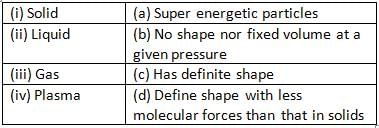Matter In Our Surroundings - Olympiad Level MCQ, Class 9, Science - Class 9 MCQ
25 Questions MCQ Test - Matter In Our Surroundings - Olympiad Level MCQ, Class 9, Science
Which of the following does not affect rate of evaporation?
Mixture of butane, ethane and propane is called :-
In the kinetic theory of gases, it is assumed that molecular collisions are :-
Triple point of water is :-
Based on the statements given here choose the correct answer.
(1) Some sugar can be added to a full glass of water without causing overflow.
(2) Liquid have spaces present between the molecules.
Van der waal's forces are also known as :-
Based on the statements given here choose the correct answer.
(1) If we increase the temperature of a gas inside a container, its pressure also increases.
(2) Upon heating, the rate of collisions of the gas molecules increase and increases the impact of force on the walls of the container.
Match the following and choose the correct answer :-

Which is more effective in cooling?
When water particles condenses on air on dust, it forms :-
Which of the following is not matter?
The temperature at which Celsius and Fahrenheit scales show the same reading is :-
Latent heat of fusion for ice is :-
Based on the statements given here choose the correct answer.
(1) In polar regions aquatic life is safe in water under frozen ice.
(2) Water has a high latent heat of fusion and the upper portion of ice does not allow the heat of the water to escape to the surroundings.
Based on the statements given here choose the correct answer.
(1) Boiling point of a liquid increases with increase in temperature.
(2) The volume of liquids increases on boiling and the vaporisation curve shows the variation of the boiling point of a liquid with pressure and expands the equilibrium state between liquid and vapour phase.
In an experiment of conversion of ice into water and water into vapour, observations were recorded and a graph plotted for temperature against time as shown below. From the graph it can be concluded that :-
The SI unit of temperature is :-
Which of the following has highest kinetic energy?
The solid state of CO2 is called :-
Corresponding temperature in the Kelvin scale for 104° F is :-
When the vapor pressure of a liquid is equal to its atmospheric pressure, then it:-
When ice is converted into water :-
Rearing and breeding of fish in pound, tanks and artificial reservoirs is called :-
Which one of the following is the indigenous breed of chickens :-
Tick the viral disease of cattle :-


















